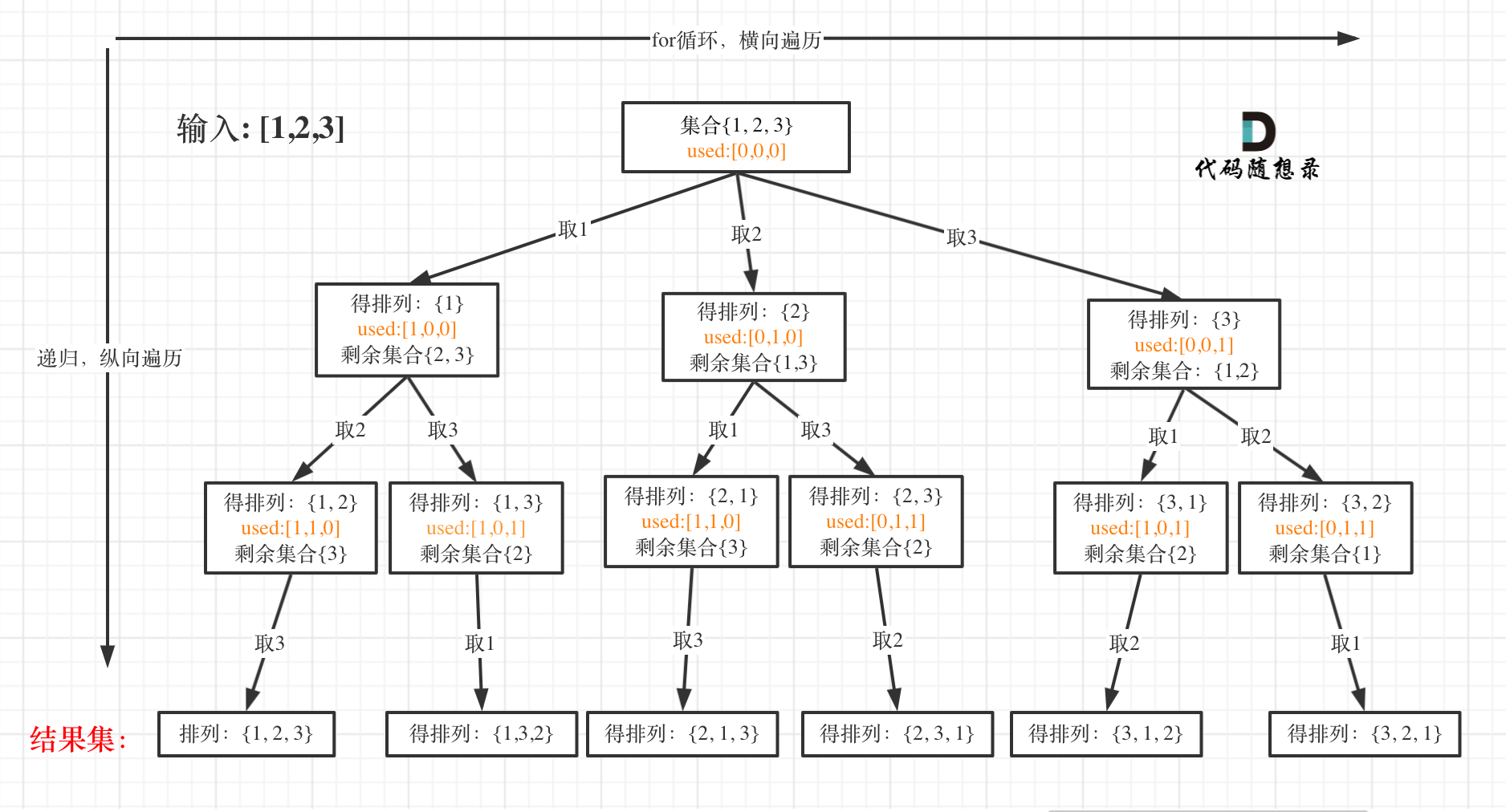



欢迎大家参与本项目,贡献其他语言版本的代码,拥抱开源,让更多学习算法的小伙伴们收益!
## 46.全排列
[力扣题目链接](https://leetcode-cn.com/problems/permutations/)
给定一个 没有重复 数字的序列,返回其所有可能的全排列。
示例:
输入: [1,2,3]
输出:
[
[1,2,3],
[1,3,2],
[2,1,3],
[2,3,1],
[3,1,2],
[3,2,1]
]
## 思路
**如果对回溯算法基础还不了解的话,我还特意录制了一期视频:[带你学透回溯算法(理论篇)](https://www.bilibili.com/video/BV1cy4y167mM/)** 可以结合题解和视频一起看,希望对大家理解回溯算法有所帮助。
此时我们已经学习了[77.组合问题](https://programmercarl.com/0077.组合.html)、 [131.分割回文串](https://programmercarl.com/0131.分割回文串.html)和[78.子集问题](https://programmercarl.com/0078.子集.html),接下来看一看排列问题。
相信这个排列问题就算是让你用for循环暴力把结果搜索出来,这个暴力也不是很好写。
所以正如我们在[关于回溯算法,你该了解这些!](https://programmercarl.com/回溯算法理论基础.html)所讲的为什么回溯法是暴力搜索,效率这么低,还要用它?
**因为一些问题能暴力搜出来就已经很不错了!**
我以[1,2,3]为例,抽象成树形结构如下:

## 回溯三部曲
* 递归函数参数
**首先排列是有序的,也就是说[1,2] 和[2,1] 是两个集合,这和之前分析的子集以及组合所不同的地方**。
可以看出元素1在[1,2]中已经使用过了,但是在[2,1]中还要在使用一次1,所以处理排列问题就不用使用startIndex了。
但排列问题需要一个used数组,标记已经选择的元素,如图橘黄色部分所示:

代码如下:
```
vector> result;
vector path;
void backtracking (vector& nums, vector& used)
```
* 递归终止条件

可以看出叶子节点,就是收割结果的地方。
那么什么时候,算是到达叶子节点呢?
当收集元素的数组path的大小达到和nums数组一样大的时候,说明找到了一个全排列,也表示到达了叶子节点。
代码如下:
```
// 此时说明找到了一组
if (path.size() == nums.size()) {
result.push_back(path);
return;
}
```
* 单层搜索的逻辑
这里和[77.组合问题](https://programmercarl.com/0077.组合.html)、[131.切割问题](https://programmercarl.com/0131.分割回文串.html)和[78.子集问题](https://programmercarl.com/0078.子集.html)最大的不同就是for循环里不用startIndex了。
因为排列问题,每次都要从头开始搜索,例如元素1在[1,2]中已经使用过了,但是在[2,1]中还要再使用一次1。
**而used数组,其实就是记录此时path里都有哪些元素使用了,一个排列里一个元素只能使用一次**。
代码如下:
```
for (int i = 0; i < nums.size(); i++) {
if (used[i] == true) continue; // path里已经收录的元素,直接跳过
used[i] = true;
path.push_back(nums[i]);
backtracking(nums, used);
path.pop_back();
used[i] = false;
}
```
整体C++代码如下:
```CPP
class Solution {
public:
vector> result;
vector path;
void backtracking (vector& nums, vector& used) {
// 此时说明找到了一组
if (path.size() == nums.size()) {
result.push_back(path);
return;
}
for (int i = 0; i < nums.size(); i++) {
if (used[i] == true) continue; // path里已经收录的元素,直接跳过
used[i] = true;
path.push_back(nums[i]);
backtracking(nums, used);
path.pop_back();
used[i] = false;
}
}
vector> permute(vector& nums) {
result.clear();
path.clear();
vector used(nums.size(), false);
backtracking(nums, used);
return result;
}
};
```
## 总结
大家此时可以感受出排列问题的不同:
* 每层都是从0开始搜索而不是startIndex
* 需要used数组记录path里都放了哪些元素了
排列问题是回溯算法解决的经典题目,大家可以好好体会体会。
## 其他语言版本
Java:
```java
class Solution {
List> result = new ArrayList<>();// 存放符合条件结果的集合
LinkedList path = new LinkedList<>();// 用来存放符合条件结果
boolean[] used;
public List> permute(int[] nums) {
if (nums.length == 0){
return result;
}
used = new boolean[nums.length];
permuteHelper(nums);
return result;
}
private void permuteHelper(int[] nums){
if (path.size() == nums.length){
result.add(new ArrayList<>(path));
return;
}
for (int i = 0; i < nums.length; i++){
if (used[i]){
continue;
}
used[i] = true;
path.add(nums[i]);
permuteHelper(nums);
path.removeLast();
used[i] = false;
}
}
}
```
```java
// 解法2:通过判断path中是否存在数字,排除已经选择的数字
class Solution {
List> result = new ArrayList<>();
LinkedList path = new LinkedList<>();
public List> permute(int[] nums) {
if (nums.length == 0) return result;
backtrack(nums, path);
return result;
}
public void backtrack(int[] nums, LinkedList path) {
if (path.size() == nums.length) {
result.add(new ArrayList<>(path));
}
for (int i =0; i < nums.length; i++) {
// 如果path中已有,则跳过
if (path.contains(nums[i])) {
continue;
}
path.add(nums[i]);
backtrack(nums, path);
path.removeLast();
}
}
}
```
Python:
```python3
class Solution:
def permute(self, nums: List[int]) -> List[List[int]]:
res = [] #存放符合条件结果的集合
path = [] #用来存放符合条件的结果
used = [] #用来存放已经用过的数字
def backtrack(nums,used):
if len(path) == len(nums):
return res.append(path[:]) #此时说明找到了一组
for i in range(0,len(nums)):
if nums[i] in used:
continue #used里已经收录的元素,直接跳过
path.append(nums[i])
used.append(nums[i])
backtrack(nums,used)
used.pop()
path.pop()
backtrack(nums,used)
return res
```
Python(优化,不用used数组):
```python3
class Solution:
def permute(self, nums: List[int]) -> List[List[int]]:
res = [] #存放符合条件结果的集合
path = [] #用来存放符合条件的结果
def backtrack(nums):
if len(path) == len(nums):
return res.append(path[:]) #此时说明找到了一组
for i in range(0,len(nums)):
if nums[i] in path: #path里已经收录的元素,直接跳过
continue
path.append(nums[i])
backtrack(nums) #递归
path.pop() #回溯
backtrack(nums)
return res
```
Go:
```Go
var res [][]int
func permute(nums []int) [][]int {
res = [][]int{}
backTrack(nums,len(nums),[]int{})
return res
}
func backTrack(nums []int,numsLen int,path []int) {
if len(nums)==0{
p:=make([]int,len(path))
copy(p,path)
res = append(res,p)
}
for i:=0;i




